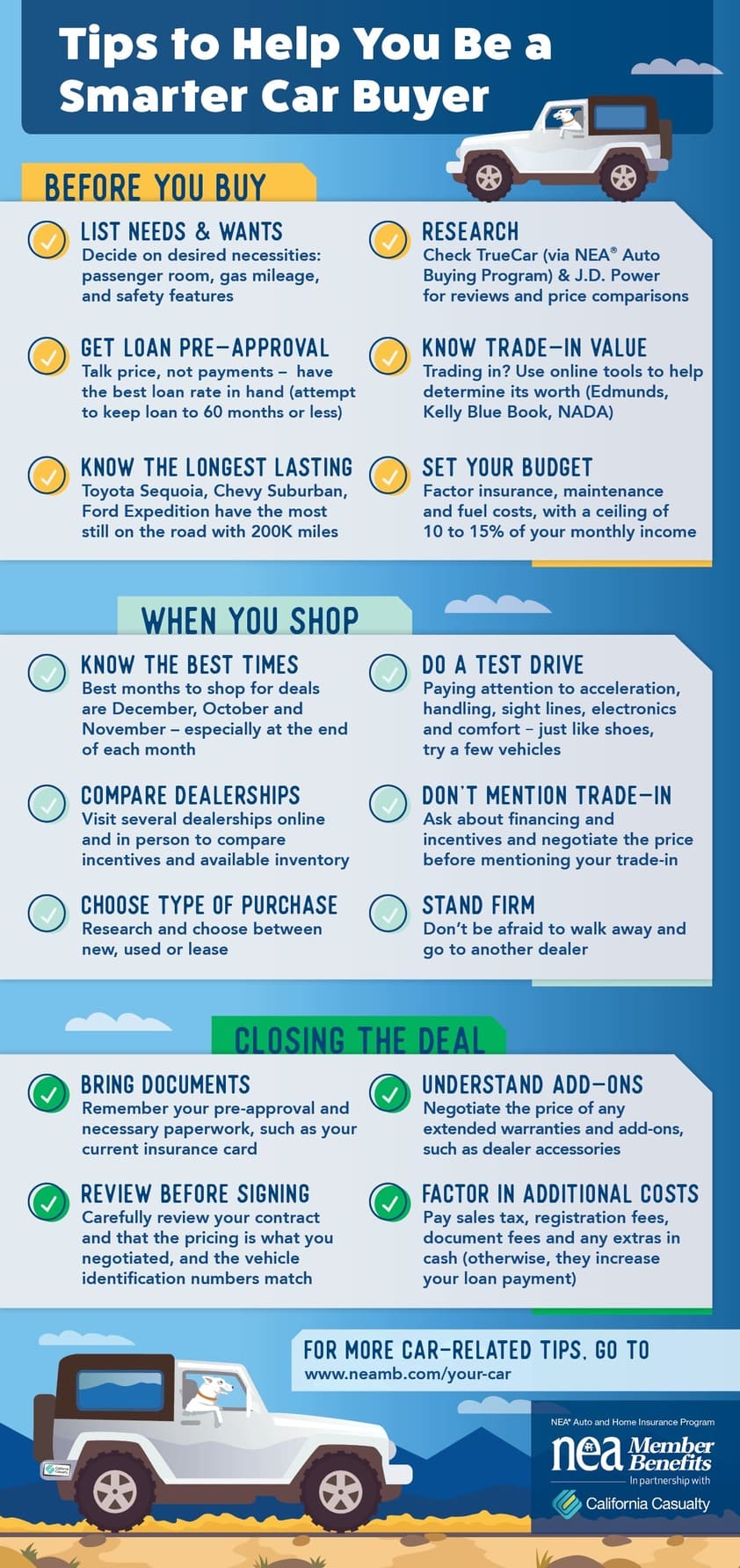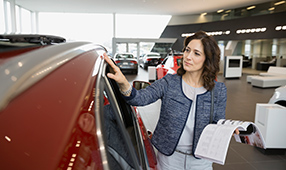Key takeaways
- The sticker price is only a starting point—you can negotiate the final cost down from there.
- Timing means everything because dealers are eager to sell toward the end of the year.
- Understand dealer invoice basics to help you whittle down the price even more.
One of the best things about car shopping is that the sticker price is only a suggested price. In fact, it’s really a starting point from which you can negotiate to reduce the cost by hundreds or even thousands of dollars.
To help you reduce that sticker price by as much as you can—and pick up on other smart shopping tips—we asked for advice on how to buy a car from Dealertrack.com, which helps dealers manage their finances, in part, by knowing what to charge for cars. As a business that advises dealers, Dealertrack knows the ins and outs of buying a car. That’s why the following tips are so valuable—it’s like getting great “inside information” so you can easily navigate the negotiations and buying processes.
Here are the steps to buying a car, according to what Dealertrack shared with us, along with additional recommendations/resources we found:
1. Choose the right time to buy. From the fall through the end of the year is the best time to buy a car, especially at the end of each month. The reason: The current-year inventory must get cleared so dealers can make room for the newest vehicles. If you’re buying or leasing a new one, you’ll get the best deals on last year’s models, so focus on getting the dealer to lower those prices.
2. Do the math before committing to a used car over a new one. Dealertrack wisely suggests doing some simple math to help you calculate the true cost of a used vehicle, to compare it to that of a new model:
- Get the manufacturer’s extended warranty. Add that to the sale price. Focus on certified, pre-owned vehicles, because they’re considered “a safer bet” for lower maintenance costs.
- Calculate your annual mileage based on recent driving habits. Figure out how many miles you’ll put on the vehicle in the coming ownership period and that can let you ...
- ... Calculate scheduled maintenance and when it’s required. You can find most owner’s manuals through a quick Google search. See what maintenance may be expected for the car (such as a timing belt change) and ask a qualified mechanic or the dealership’s service department what that maintenance costs. Now add that amount to the sticker price.
- Now that you have this higher number, go shop for new cars and especially new-car lease offers, and calculate how much more they might be a used one. If you’re even close between new and used, the new car probably is the smarter buy.
3. Decipher the dealer invoice. The invoice is what the dealer paid for the vehicle. The sticker price is the “suggested” retail price of the car. The dealer sets the latter, but he or she is stuck with the former by the manufacturer. That difference is the dealer’s potential profit. And since the dealer needs to move inventory, you can counteroffer a price that still allows for some profit, while substantially lowering the sticker amount.
Websites such as Edmunds.com show the invoice, which – unlike the manufacturer's suggested retail price (MSRP) on the site—does not vary from dealer to dealer. Knowing the dealer invoice and MSRP should give you some sense of what the transaction price should be. That price might go somewhat higher if you’re shopping for a popular car. You also can look up transaction prices for new cars on a site such as KBB.com, which gives you a “fair market price” based on actual sales of the make and model you’re shopping for in your area. KBB.com—along with other sites such as J.D. Power and the NEA Auto Buying Program—offer useful reviews as well.
4. Get a better deal through savvy negotiating. Once you’re armed with the information above, you can use it to your advantage. Here are a few tactics that could help you get a better price.
- Don’t “fall in love”—but if you do, don’t show it! Meaning, if you happen to find your “dream car” and you just won’t settle for any other, don’t let the sales team know. Make it clear that you’re considering several choices at the moment and that you would be perfectly happy with any of them. Walk off the lot if need be to demonstrate your willingness to pursue other options. Then come back and ask the sales team if you can get a better price than offered before.
- Make dealers compete with each other. Collect and compare multiple quotes for multiple vehicles at multiple dealerships that are essentially the equivalent in terms of value, preferences, features, etc. Then, leverage those quotes. Encourage the salesmen to top each other in getting you the best offer. Take test drives at each dealership to not only get a sense of handling, electronics and comfort, but to present yourself as a serious buyer. (Make it clear, however, that you’re test driving at a number of locations.)
- Don’t mention the possibility of a trade-in. Get your best offer that includes financing, incentives and, of course, a great price. THEN, you can talk about trade-in value.
- Check emotions at the door. Think of negotiating as simply business, nothing personal. Don’t let flattery or pressure tactics force your decision. If you have difficulty doing this, try negotiating via email or text messages first. This way you not only take face-to-face interactions out of the equation, but you will have all of your quotes and terms in writing.
- Review everything before signing. Once you have the best price on the car you’ve chosen, look over the final paperwork to verify that the pricing is what you negotiated, and that the vehicle identification numbers match. Make sure the dealer isn’t sneaking in any additional, undisclosed fees or add-on “extras.” If there are add-ons that you do want, negotiate those costs individually instead of accepting the first offer on each as a final one.
5. Find bargains using your NEA membership benefits. If you shudder at the thought of negotiating, there are ways to avoid it.By taking advantage of a car buying service, such as the NEA Auto Buying Program, you’ll find great, hassle-free deals on new and used models from TrueCar-screened dealerships near you before you head to the lot. Pick out your car and head to the dealership with a price already in hand. In addition, many of the dealers offer an extra member-only discount off the final negotiated price, and a free CARFAX report is available on some of the listed vehicles.
Here's a handy chart that will help you when you're researching what to buy, shopping for your new vehicle, negotiating a good price and closing the deal.













